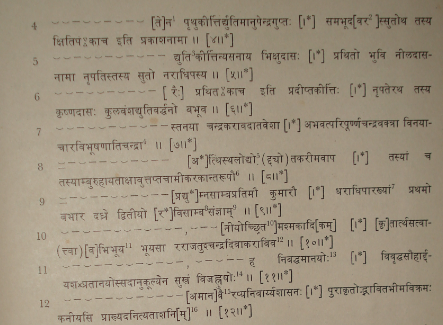|
INSCRIPTIONS OF THE MINISTERS AND FEUDATORIES OF THE
VATSAGULMA BRANCH

____________________
1 Bhagvanlal read नेश here. Bühler also read the second akshara as श, but the facsimile shows the
reading तेन to be correct.
2 Bhagvanlal doubtfully read दगजः and gave दवनं as a possible reading. Bühler admitted that दव
was clear. The intended word may be दवर- or possibly दपर-.
3 Bhagvanlal and, following him, Bühler द्भुवि, but the second akshara is clearly ति, as its curve
is not closed at the bottom. The preceding akshara is probably द्यु.
4 Bhagvanlal omitted the akshara preceding चन्द्रा, but Bühler read the name as सुचन्द्रा. The akshara preceding चन्द्रा does not, however, appear like सु and has, besides, a curve at the top. The repetition
of चन्द्र in the verse suggests that the name of the queen ended in चन्द्र and may have been अतिचन्द्रा.
5 These three aksharas were read by me for the first time. The description is evidently suggested
by the name Atichandrā.
6 Metre : Indravajrā (or Upajāti).
7 This expression has been variously read. Bhau Daji read it as धराधिपत्ये प्रथमावातारम्. Bhagvanlal’s
reading was एकाधिपत्यप्रथमावतारम्, which Bühler changed into एकाधिपत्यं प्रथमो वभार. The facsimile will
show that the correct reading is as given above.
8 Bhau Daji first read the name as रविसाम्व and the reading has been adopted by subsequent editors.
The first akshara has a somewhat peculiar form, but in view of the names Harisāmba and Śaurisāmba occurring in v. 3, It is not unlikely that the intended name was Ravisāmba.
9 Metre : Upajāti.
10 These four aksharas read by me for the first time are almost certain.
11 Bhagvanlal and Bühler read नुताभ्याममिभूय.
12 Metre of verse 10-13 : Vaṁśastha.
13 These seven aksharas are almost certain.
14 Bhau Daji and Bhagvanlal read विजह्लतोः which is ungrammatical. The correct reading was
first given by Bühler.
15 This word is completed here for the first time.
16 Bhau Daji read प्रेत्य च नित्यताशनि:, while Bhagvanlal gave only प्र. . . . शनिः Bühler suggested
प्रास्यत . . . . शनिः. The aksharas following प्रा is undoubtedly ख्य. See the from ख्य in धराधिपाख्याम् in
line 9 above. The following aksharas also are not very doubtful. अनित्य is repeated in the next verse.
|